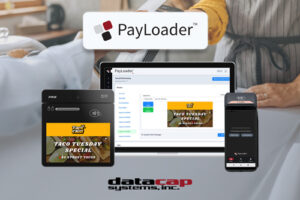 Consumer expectations for payment solutions are evolving rapidly as they discover emerging technologies that deliver greater convenience. Modern consumers gravitate toward seamless, flexible payment experiences that align with their busy lifestyles. For proof, you don’t have to look further than increasing digital wallet adoption. Some consumers are even leaving home without cash or cards, relying solely on their smartphones to make payments. Merchants who deploy flexible payment devices capable of accepting a broad range of payments will capture more business.
Consumer expectations for payment solutions are evolving rapidly as they discover emerging technologies that deliver greater convenience. Modern consumers gravitate toward seamless, flexible payment experiences that align with their busy lifestyles. For proof, you don’t have to look further than increasing digital wallet adoption. Some consumers are even leaving home without cash or cards, relying solely on their smartphones to make payments. Merchants who deploy flexible payment devices capable of accepting a broad range of payments will capture more business.
Payment Device Features for Flexible, Future-Proof Solutions
ISVs and VARs developing solutions for 2025 and beyond must prioritize equipping their clients with flexible, scalable, and future-proof payment devices. Here are the key features to look for when you’re evaluating payment devices.
- Android OS
Android is the most widely used operating system in the world, and its adoption in payment-focused devices is growing. Unlike proprietary payment technology software, Android is easier to develop for and integrate with, allowing providers to innovate and expand device functionality.
Payment tools powered by Android can support a broader range of payment methods, such as QR code payments and mobile payment apps. Additionally, Android terminals can integrate advanced features directly onto the device, such as loyalty rewards and digital receipts, while maintaining strong security and PCI compliance.
Android’s versatility extends beyond traditional payment terminals to kiosks, mobile devices, and countertop terminals, making it a robust choice for various use cases. It is the only option for payment device operating systems, but it’s increasingly popular among your clients. - Remote Device Management
Payment device downtime can disrupt workflows, impact customer service, and result in lost sales. Remote device management empowers you and your clients to address challenges by enabling updates, repairs, and configurations without requiring onsite service.
Key benefits of remote device management include:
- Centralized Updates: Administrators can manage updates and security patches across all devices from a single location.
- Feature Deployment: You and your clients can add new features or capabilities remotely without visiting each site.
- Remote Key Injection: This feature eliminates the need to send devices to a key injection facility. Devices can be delivered directly to their intended locations, with encryption keys injected remotely. This saves time and costs while enhancing security.
- Dynamic Branding: You can change branding on the device and enable advertising. For example, a pizza shop could display its logo and rotate ads for specials, all managed from a central location. On the other hand, you can have your logo on the splash screen to elevate your branding in your market.
These capabilities reduce implementation and maintenance costs, streamline operations, and enhance security, making remote device management a must-have feature.
- Form Factors Suited to the Use Case
Consumers make payments in more places and more ways than ever before, from curbside to kiosks, mobile devices, and traditional countertops. Payment devices should align with these diverse use cases, offering multiple form factors within a standardized line. Standardizing with a single vendor simplifies maintenance while ensuring device compatibility.
High-quality devices for payments should be resistant to damage from heavy consumer use, while user-friendly and aesthetically pleasing. Make sure your payment partner’s portfolio includes compact, space-saving designs and devices with multiple connectivity options so that your clients can accept payments anywhere.
Payment Device Features for Flexible, Future-Proof Solutions
Choosing the right payment device involves more than selecting hardware. It’s essential to evaluate the solutions and services offered by device providers. Before making your choice, take a look at:
- OEM Roadmaps: Assess their plans for innovation and the longevity of terminal support.
- Payment Solutions Provider: Determine whether the provider offers flexibility in processor choice. Look for provider support for a variety of OEMs to offer diverse device options. Also ensure they provide value-added services like gift and loyalty and robust user-friendly reporting capabilities.
A strong partnership with a reliable payments partner will result in additional value and ensure your payment solutions remain competitive.
Where to Turn for Advice
Industry insiders can help you find the best solutions tailored to your market and customers. Contact us to learn how we can help you navigate the complexities of payments, from device selection to service implementation.



